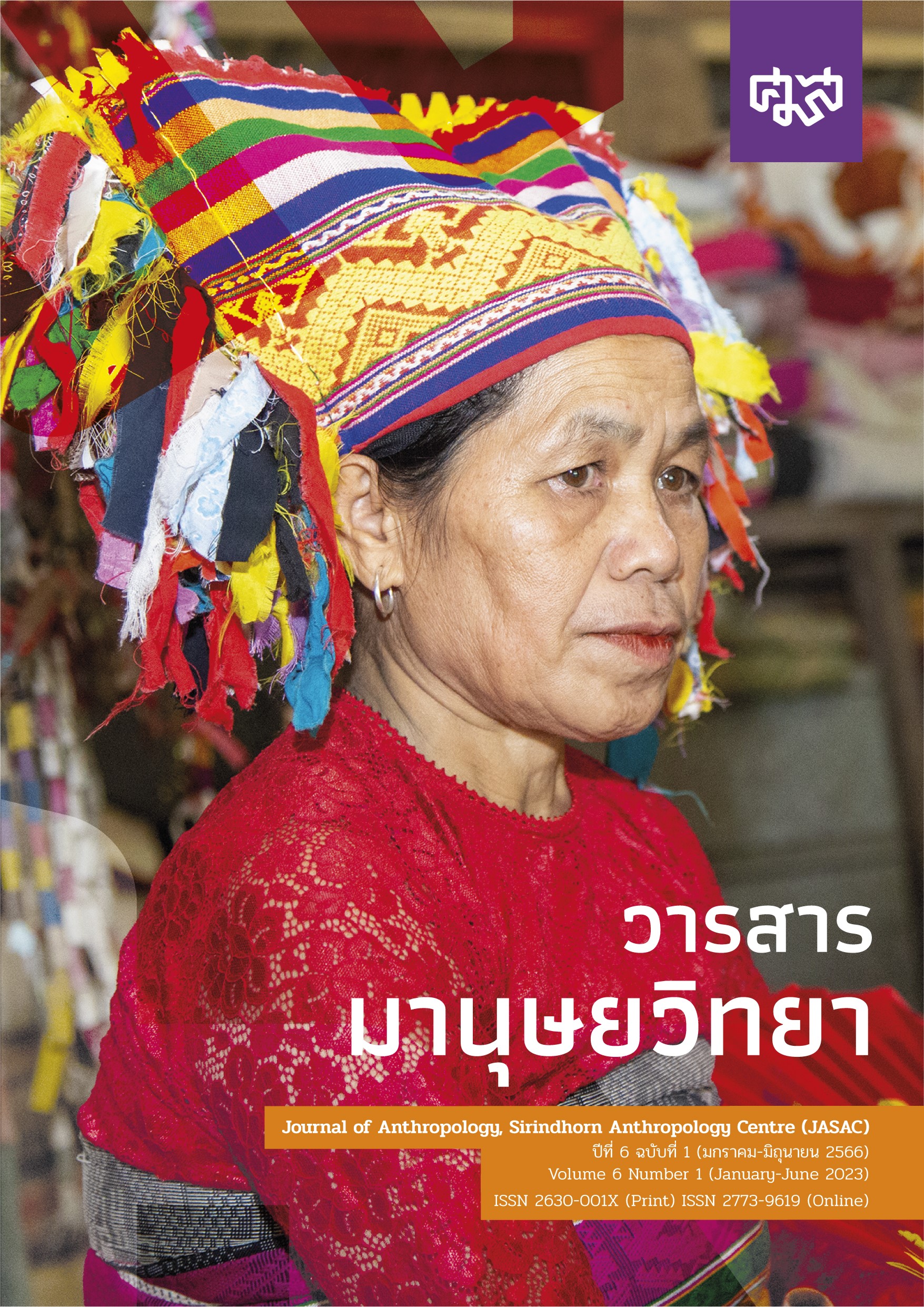จาก “กะเทย” สู่ “ผู้หญิงข้ามเพศ” การเปลี่ยนแปลงเชิงวาทกรรมว่าด้วยอัตลักษณ์ทางเพศในสังคมไทย
Main Article Content
บทคัดย่อ
คำว่า “ผู้หญิงข้ามเพศ” ปรากฏต่อสาธารณชนครั้งแรกในปี พ.ศ. 2553
ในรายการโทรทัศน์ นก ยลลดา ได้อธิบายความหมายของผู้หญิงข้ามเพศว่า เป็นผู้หญิงที่เกิดมาในร่างกายผู้ชาย และเป็นความผิดปกติหรืออาการป่วย อย่างหนึ่งที่ต้องได้รับการรักษา การปรากฏของคำว่า “ผู้หญิงข้ามเพศ” ทำให้เกิดการวิพากษ์วิจารณ์กันอย่างกว้างขวาง และเกิดกระแสการต่อต้าน ไม่เห็นด้วยจากสังคมวงกว้าง โดยส่วนใหญ่มองว่าคำว่าผู้หญิงข้ามเพศว่าก่อ ให้เกิดความสับสนต่อสังคมและไม่มีความจำเป็น เพราะผู้หญิงข้ามเพศก็คือ กะเทยตามความเข้าใจของสังคม บทความนี้มุ่งทำความเข้าใจการเปลี่ยนแปลงความหมายจากคำว่า “กะเทย” สู่ “ผู้หญิงข้ามเพศ” ผ่านการศึกษาเอกสารวิชาการ สิ่งพิมพ์ และสื่อดิจิตัล และสะท้อนให้เห็นการเปลี่ยนแปลงแนวคิด
และความเข้าใจเรื่องอัตลักษณ์ทางเพศในสังคมไทยที่ได้รับอิทธิพลจากหลักการการกำหนดนิยามเพศด้วยตนเอง (Gender self-determination) บทความนี้นำเสนอว่าการเกิดขึ้นของ “ผู้หญิงข้ามเพศ” เป็นความพยายามในการช่วงชิงความหมายของความเป็นผู้หญิงและต่อสู้เพื่อให้หลุดจากความเป็น “กะเทย”
Article Details

อนุญาตภายใต้เงื่อนไข Creative Commons Attribution-NonCommercial-NoDerivatives 4.0 International License.
ลิขสิทธิ์@ของวารสารมานุษยวิทยา
ศูนย์มานุษยวิทยาสิรินธร (องค์การมหาชน), กรุงเทพฯ, ประเทศไทย
ข้อมูลเพิ่มเติม:
https://creativecommons.org/licenses/by-nc-nd/4.0/
เอกสารอ้างอิง
กนกวรรณ ธราวรรณ. (2555). รัฐไทยกับชีวิตคู่แบบเพศวิถีนอกขนบ. ใน กุลภา วจนสาระ และกฤตยา อาชวนิจกุล, (บก.). ประชากรและสังคม 2555: ประชากรชายขอบและความเป็นธรรมในสังคมไทย. นครปฐม: สถาบันวิจัยประชากรและสังคม มหาวิทยาลัยมหิดล.
กฤตยา อาชวนิจกุล และกนกวรรณ ธราวรรณ. (2550). วิเคราะห์วิธีคิดวิทยาในงานวิจัยเรื่องเพศภาวะและเพศวิถีกับเอดส์ศึกษา. กรุงเทพฯ: มูลนิธิสร้างความเข้าใจเรื่องสุขภาพผู้หญิง.
ชนาธิป สุวรรณานนท์. (2563). กะเทยบันทึก: “รื้อ” ความหมายและตัวตนจากจดหมายเหตุส่วนบุคคลและเรื่องเล่า. วิทยานิพนท์ศิลปศาสตรมหาบัณฑิต สตรี เพศสถานะ และเพศวิถีศึกษา มหาวิทยาลัยธรรมศาสตร์.
ชิษณุพงศ์ นิธิวนา. (2563). กะเทย: การศึกษาความหลากหลายที่มองไม่เห็นด้วยตาเปล่า ใน วิจิตร ประพงษ์ (บก.), ความ (ไม่) เป็นหญิง ความ (ไม่)เป็นชาย ความ (ไม่) เป็นคน. (หน้า 31-59). เชียงใหม่: คณะสังคมศาสตร์ มหาวิทยาลัยเชียงใหม่.
ชีรา ทองกระจาย (2557). เพศ ยุทธศาสตร์: พลวัตการดิ้นรนต่อรองทางเพศของกะเทยไทยพลัดถิ่นในยุโรป (Gender and Sexual Strategies: Struggle and Negotiation for Life of Thai Kathoey Migrants in Europe). วารสารเพศวิถีศึกษา. 3(1). 77-96.
ชีรา ทองกระจาย (2563). ความหลากหลายทางเพศในองค์กรรัฐ. สํานักงานกองทุนสนับสนุนการวิจัย และกรมกิจการสตรีและสถาบันครอบครัว.
ชลิดาภรณ์ ส่งสัมพันธ์. (2551). ประวัติศาสตร์ของเพศวิถี: ประวัติศาสตร์เรื่องเพศ/เรื่องเพศใน ประวัติศาสตร์ไทย. กรุงเทพฯ: มูลนิธิสร้างความเข้าใจเรื่องสุขภาพผู้หญิง (สคส.).
เทิดศักดิ์ ร่มจําปา. (2545). วาทกรรมเกี่ยวกับ เกย์ ในสังคมไทย พ.ศ.2508-2542. วิทยานิพนท์อักษรศาสตรมหาบัณฑิต จุฬาลงกรณ์มหาวิทยาลัย.
นฤพนธ์ ด้วงวิเศษ. (2556). เพศหลากหลายในสังคมไทยกับการเมืองของอัตลักษณ์. วารสารสังคมศาสตร์. 25(2). 137-168.
ประชาไท. (2565). เสวนาเนื่องใน วันนอนไบนารีสากล นักวิจัยแนะต้องมองถึงการแก้ กม. ที่ยังอยู่ในกรอบ 2 เพศ. สืบค้นจาก https://prachatai.com/journal/2022/07/99545
เปรมปรีดา ปราโมช ณ อยุธยา. (2546). การช่วงชิงอัตลักษณ์ กระเทย ในงานคาบาเรต์โชว์. วิทยานิพนธ์ศิลปศา-สตรมหาบัณฑิต สาขาวิชาการพัฒนาสังคม มหาวิทยาลัยเชียงใหม่.
ผู้จัดการออนไลน์. (2554). เกย์นทีค้านโครงการ จิ๋มเอื้ออาทร. สืบค้นจากhttps://mgronline.com/entertainment/detail/9540000026775
พรหมมินทร์ ประไพพงษ์. (2564). ผู้หญิงข้ามเพศที่สมบูรณ์แบบ: ความสัมพันธ์ระหว่างกลวิธีทางภาษากับอัตลักษณ์ของ แอน จักรพงษ์ จักราจุฑาธิบดิ์. วรรณวิทัศน์. 21(2). 90-120.
พันทิปดอทคอม. (2553). คุณนก ยลดา ผู้หญิงข้ามเพศ ผมเกลียดคุณ. สืบค้นจากhttp://topicstock.pantip.com/chalermthai/topicstock/2010/03/8933214/A8933214.html
ยลลดา เกริกก้อง สวนยศ. (2554). ผู้หญิ๊ง ผู้หญิง ใคร ๆ ก็หาว่าเธอบ้า. กรุงเทพฯ: บริษัท ส.เอเชียเพรส จํากัด
วัชรวุฒิ ซื่อสัตย์, พัชรินทร์ สิรสุนทร และฐานิดา บุญวรรโณ. (2565). การปรากฏอัตลักษณ์ กายา และอาณาบริเวณทางสังคมของกะเทยในเอเชียตะวันออกเฉียงใต้ (พ.ศ. 2470-2516). วารสารดํารงวิชาการ. 21(1). 165-204.
สถาบันภาษา จุฬาลงกรณ์มหาวิทยาลัย (2563). (ไม่มีหัวข้อเรื่อง). สืบค้นจากhttps://www.facebook.com/CULIChula/photos/a.1646719355407158/3564519250293816/?type=3
สุไลพร ชลวิไล. (2562). เพศแห่งสยาม ประวัติศาสตร์ความหลากหลายทางเพศ. กรุงเทพฯ: สถาบันพิพิธภัณฑ์การเรียนรู้แห่งชาติ.
Sanook.com. (2553). วู้ดดี้เกิดมาคุย: ผู้หญิงข้ามเพศ. สืบค้นจาก https://www.sanook.com/video/clip/409245/
Spectrum. (2564). Misgendering on Media: การเรียกเพศผิดในสื่อไทย.สืบค้นจาก https://www.facebook.com/showyourspectrum/photos/a.276495186375492/736521670372839
Altman, D. (1996). Rupture or Continuity? The Internationalization of Gay Identities. Social Text, 48, 77-94. Retrieved from https://doi.org/10.2307/466787
Duangwises N. and Jackson P. (2021). Effeminacy and Masculinity in Thai Gay Culture: Language, Contextuality and the Enactment of Gender Plurality. Walailak Journal of Social Science. 4 (5),1- 23. https://so06.tci-thaijo.org/index.php/wjss.
FELGTBI+. (n.d.). Right to Self-Determination of Gender: Comparative Law Study on Five Questions Related to Gender Identity. Retrieved from https://www.dentons.com/en/about-dentons/ an-entrepreneurial-approach-to-pro-bono-and-social-responsibility/-/media/281f3d002b2348699ed89f371b9ed14c.ashx
Foucault, M. (1976). La volonté de savoir, vol. 1. Histoire de la sexualité. Paris: Gallimard.
Jackson, P. (1997). Kathoey>< Gay >
Jackson, P. (1999). Tolerant but Unaccepting: The Myth of a Thai ’Gay Paradise. In Jackson P.& Cook N. (Eds.), Genders and Sexualities in Modern Thailand. (pp. 226-260). Chiang Mai: Silkworm Books
Jackson, P. (2000). An Explosion of Thai Identities: Global Queering and Re-imagining Queer Theory. Culture, Health & Sexuality, 2(4), 405-424. Retrieved from https://doi.org/10.1080/13691050050174422
Jackson, P. (2003). Performative Genders, Perverse Desires: A Bio-History of Thailand's Same-Sex and Transgender Cultures. Intersections: Gender and Sexuality in Asia and the Pacific. 9, 1-52.Retrieved from http://intersections.anu.edu.au/issue9/jackson.html
Jackson, P. (2009). Capitalism and Global Queering: National Markets, Parallels among Sexual Cultures, and Multiple Queer Modernities. GLQ: A Journal of Lesbian and Gay Studies, 15(3), 357-395. Retrieved from https://doi.org/10.1215/10642684-2008-029
Jackson, P. (2011). Queer Bangkok: 21st Century Markets, Media,and Rights. Hong Kong University Press. Retrieved from http://www.jstor.org/stable/j.ctt1xwdfx
Jackson P. & J Dunagwises N. (2020). Review of Studies of Gender and Sexual Diversity in Thailand in Thai and International Academic Publications. The 13th International Conference of Thai Studies, Chiang Mai, 15-18 July 2017. Retrieved from https://www.researchgate.net/publication/344665651 _Review_of_Studies_of_Gender_and_Sexual_Diversity_in_ Thailand_in_Thai_and_International_Academic_Publications_1
Käng, D. B. (2012). Kathoey“In Trend”: Emergent Genderscapes, National Anxieties and the Re-Signification of Male-Bodied Effeminacy in Thailand. Asian Studies Review, 36(4), 475- 494. Retrieved from https://doi.org/10.1080/10357823.2012.741043.
Käng, D.B. (2014). Conceptualizing Thai Genderscapes: Transformation and Continuity in the Thai Sex/Gender System. In: Liamputtong, P.(Eds.) Contemporary Socio-Cultural and Political Perspectives in Thailand. Springer, Dordrecht. Retrieved from https://doi.org/10.1007/978-94-007-7244-1_26.
Matzner, A. (2001). The Complexities of Acceptance: Thai Student Attitudes towards Kathoey. Crossroads: An Interdisciplinary Journal of Southeast Asian Studies, 15(2), 71-93
Ojanen, T. (2014). The Thai Delphi Panel: Impact of Structural Factorson Gender and Sexuality in Thailand in 1980-2010. In Boonmongkon P. and Ojanen T. (Eds.), Mobile sexualities: Transformations of gender and sexuality in Southeast Asia. The Southeast Asian Consortium on Gender, Sexuality, and Health. (pp. 55-166). Nakhon Pathom: Mahidol University.
Rodat, S. (2014). Cyberqueer-Major Topics and Issues in Current Research. Retrieved from https://www.revistadesociologie.ro/pdf-uri/nr.5-6-2014/03-SimonaR.pdf
Stanley, E.A. (2014). Gender Self-Determination. TSQ: Transgender Studies Quarterly. 1(1-2). 89-91.
Stone, S. (1992). The Empire Strikes Back: A Posttranssexual Manifesto. Camera Obscura: Feminism, Culture, and Media Studies, 10(2), 150-176. Retrieved from https://doi.org/10.1215/ 02705346-10-2_29-150
Sinnott, M. (2000). The Semiotics of Transgendered Sexual Identity in the Thai Print Media: Imagery and Discourse of the Sexual Other. Culture, Health & Sexuality, 2(4), 425-440. Retrieved from https://doi.org/10.1080/13691050050174431
Sinnott, M. (2004). Toms and Dees: Transgender Identity and Female Same-Sex Relationships in Thailand. SilkwormBooks.
Thongkrajai, C. (2014). Note de recherche : Phu-ying-kham-phetvs. kathoey : l’évolution du (trans)genre et l’émergence de l’identité de transfemale en Thaïande contemporaine. Anthropologica, 56(1), 69-82. Retrieved from http://www.jstor.org/stable/24469642
Thongkrajai, C. (2022). Femininity in Transition: Sex, Gender, andSexuality Experiences of Thai Transgender Migrants in Europe. Advances in Southeast Asian Studies, 15(2), 177-194. Retrieved from https://doi.org/10.14764/10.ASEAS-0077
Totman, R. (2003). The Third Sex: Kathoey-Thailand’s Ladyboys. London: Souvenir Press.
Zimman, Lal. (2019). Trans Self-Identification and the Language of Neoliberal Selfhood: Agency, Power, and the Limits of Monologic Discourse. International Journal of the Sociology of Language. Retrieved from 147-175. 10.1515/ijsl-2018-2016


